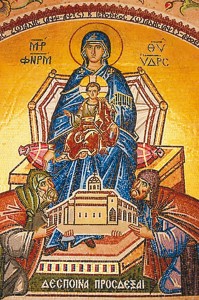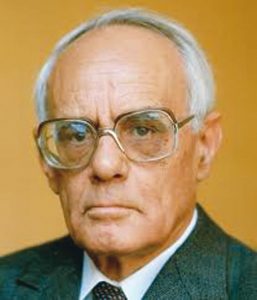Mary For Today
The Battle for a Renewed Mariology
Introduction: Any attempt to understand Mary today has to begin with the bloodiest battle of Vatican II, the issue of whether to give Mary her own document and continue along the road that had begun with the definitions of Immaculate Conception and Assumption, of exalting her privileges with new definitions as Mediatrix of all Graces and Co-redemptrix of the human race. Or to follow the direction of the council and include her in the document on the Church, which was the main topic of the Council. I am not exaggerating when I use the term ‘bloodiest battle’ because it was the turning point of two thousand years of history. Let us go backwards first, in order to go forward.
After the Assumption was defined in 1950 a split occurred between those who wished to further honour Mary with new titles, privileges, and dogmatic definitions, and those who desired to renew Marian theology and devotion by a return to original sources, a position that rose out of the early 20th century renewal through the biblical, liturgical, and ecumenical movements. The first group favoured Mary’s divine motherhood, her universal motherhood, her physical motherhood, her spiritual motherhood, her bridal motherhood. Karl Rahner took issue with this approach and proposed that grace rather than maternity should be the founding idea of Marian theology. God gives human beings a gift of grace that justifies and forgives. Rahner saw Mary as an actual realisation of this mystery, receiving God’s saving, merciful grace and, as part of human history, entirely one of us, accomplishing her own life story. She hears the word of God and acts upon it with all her heart, as we are called on to do.
Different Views: On the eve of Vatican II we have two contrasting schools of thought, those who saw Mary as an altogether special creature whose privileges paralleled those of Christ. By contrast, the position marked by the biblical, liturgical, and ecumenical movements, coupled with the renewal in the study of the church fathers, saw Mary as herself the recipient of grace and a special member of the community of the church. One was spiritually mystical in tone, driven by love, focused on the glories of Mary, full of emotional fervour, and dedicated to seeing Mary as the neck connecting the head and members of the body of Christ. The other was critically rational in tone, driven by a search for the truth, focused on Jesus Christ, full of clear-sightedness regarding the needs of the modern world, and appalled by the neck metaphor. And all this followed a century in which the Immaculate Conception and Assumption had been solemnly defined.
Clash of the Titans: Should the teaching on Mary be dealt with in the schema on the church or not? Such a simple and straightforward question was the occasion of a bitter dispute in which the titanic differences between the two millennia came into open conflict. In August of 1963 those promoting the glories of Mary opposed the move to include, supporting instead a separate document that would give Mary due regard as superior to the church. Those in favour of inclusion thought it would be more ecumenically profitable as well as in keeping with the main theme of the council itself to check exaggerations by bringing Mary back into the theology of the church.
 Culture played its part: National characteristics played a role in this division, with Spanish, Italian, Filippino, and Polish personalities favouring the maximalist heartfelt, enthusiastic strategy, while German, English, French, Belgian, and Dutch temperaments tended towards a more biblically based, theologically rigorous outlook. During the discussion the atmosphere became explosive, and almost violent. The privileges party denounced the move as a plot against Our Lady, using passionate accusations and sentimental appeals to make their case. The reform party rejected the accusations and argued that veneration of Mary could be all the more ardent if it were based on a more enlightened foundation.
Culture played its part: National characteristics played a role in this division, with Spanish, Italian, Filippino, and Polish personalities favouring the maximalist heartfelt, enthusiastic strategy, while German, English, French, Belgian, and Dutch temperaments tended towards a more biblically based, theologically rigorous outlook. During the discussion the atmosphere became explosive, and almost violent. The privileges party denounced the move as a plot against Our Lady, using passionate accusations and sentimental appeals to make their case. The reform party rejected the accusations and argued that veneration of Mary could be all the more ardent if it were based on a more enlightened foundation.
The Debate: So a calmer decision could be reached in a more informed manner, a plenary session debate was arranged. Cardinal Santos of Manila spoke for the ‘separate schema’ party and Cardinal Franz Konig of Vienna for the ‘inclusion in the church’ party. The differences between the two presentations could hardly be exaggerated. Santos gave ten arguments in favour of a separate schema. He argued that given Mary’s relation to the Trinity, she has a position of priority with regard to the church beyond the level of laity and hierarchy; the faithful would see her inclusion in the church as reduction and loss. Besides, the constitution had already been composed and there was no place where she might be harmoniously added.
Konig gave four reasons why teaching on Mary should be incorporated into the schema on the church, including the theological one that Mary belonged there because she is a type of the church, what it will one day be, the pastoral one that the faithful were being encouraged to purify their devotion to Mary and get back to essentials based on scripture, and the ecumenical one that Mary in the church made possible a conversation with both Eastern and Protestant churches. In the days between the debate and the vote of the assembly, the atmosphere grew even more tense, with propaganda pamphlets calling it all a battle for or against the Madonna. The Abbot Butler was insulted in the conservative daily paper, Il Tempo; the noted theologian Yves Congar was attacked as a ‘dishonest Catholic’ for criticising a ‘galloping Mariology’, a very bitter melodrama.
The Vote: On October 29th, 1963, the vote was finally taken. It was the closest vote of the council: 1,114 in favour of incorporating teaching on Mary into the schema on the church, 1,074 against. Forty was a legitimate and sufficient majority. The vote was met with stunned silence, ‘a moment of dazed amazement.’ The dismay arose over how could it be that the mother of God, in whose womb the fundamental union of God and humanity was achieved, had become the source of such great division? In a kind of seismic upheaval the second thousand years of Marian devotion was forcibly shifted back to realignment with the pattern of the first thousand years. When the final draft of the Dogmatic Constitution on the Church was eventually completed and voted on, it passed with only five negative votes.
Acknowledgement: The Writings of Kathleen Coyle and Elizabeth Johnson.
Next month: The First Thousand Years of Mariology.


 Entries(RSS)
Entries(RSS)